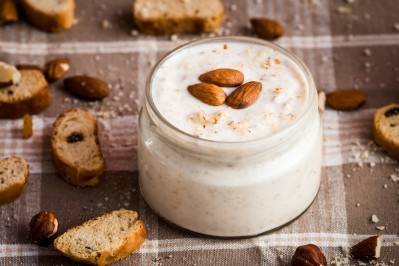From nutrition to tailored functionality: Ingredient innovation is key to dairy alternatives’ success

DairyReporter spoke to ingredient companies ADM, Beneo and ofi to find out what are some of the common denominators in the ingredient innovation space – and what are the main consumer trends that manufacturers should be mindful of.
While the alt dairy category has grown to include cell-based and precision-fermentation dairy, plant-based dairy alternatives are now firmly established and continue to grow - according to Euromonitor International, the global plant protein segment is set to expand at a CAGR of 5.1% between 2022 and 2027, with dairy alternatives showing a CAGR of 4.4%.
Perhaps unsurprisingly, improving the nutritional value of plant-based products is top priority, on a par with delivering pleasant taste and texture. But there are additional factors, such as health and sustainability concerns. According to Mike Medina, category marketing director, specialized nutrition & dairy at ADM, consumers are looking for more ‘optionality’ in their protein choices, ‘especially as many plant consumers – defined as flexitarians, vegans or vegetarians – are stating that the specific plant protein type is not as important, and they’re striving for more dietary diversity in their food and beverage consumption’.
“Specific drivers for consumer interest in alternative dairy offerings have shifted in the past few years, as shown by our most recent proprietary research comparing consumption habits from 2020 to 2023. While health and nutrition still remain key factors, plant consumers in 2023 are now interested in more specific wellness support, including improving digestion and managing allergies or intolerances,” he explained. “Additional factors motivating today’s plant consumers to purchase more alternatives to dairy include improved taste and texture, as well as animal welfare concerns.”
“Our research shows that plant consumers most want to see ‘plant-based protein sources and additional health benefits’ in the future innovation of alternative offerings.” – Mike Medina, ADM
Nutrition is of high importance for consumers seeking to bring more alternative protein options into their diets, he added. “’Enhanced nutritional profile’ is also an attribute that consumers are interested in seeing in future innovations. This is compounded by overarching consumer behavior shifts toward balanced wellness and proactive personalization,” said Medina.
He highlighted that there were opportunities in the active nutrition space, as alt dairy products are poised to tick many boxes. “Tailored functionality is also opening the door for more opportunities in alternative dairy consumption throughout the day, as well as supporting consumers’ different life stages and lifestyles,” said Medina. “From protein shakes that leverage a combination of protein sources to yogurt alternatives and on-the-go frozen treat bites, subcategories within alternative dairy are on the cusp of growth. Both active-nutrition adults and children can benefit from a greater variety of emerging subcategories that place emphasis on nutrition, taste, convenience and personalization.”
Novelty is also a factor. According to ofi’s Pilar Darre, category lead, beverages, desserts and ice cream, ‘many consumers are seeking out new experiences post-pandemic, with something as small as a novel F&B purchase creating a sense of luxury and excitement’. “As the plant-based revolution gathers momentum, some consumers are growing curious – with ofi’s 2022 EMENA survey finding that 65% of consumers see plant-based alternatives as an opportunity to try something new,” she explained.
Dairy and alternatives also differ when it comes to reasons for consumption, Darre added. “The 2023 Innova Market Insights survey reveals that one in three German consumers cite environmental or ethical reasons for consuming milk alternatives, compared to 1 in 20 for dairy milk. Perceived health attributes are another difference, with some consumers expecting dairy alternatives to provide better nutrients but a comparable taste to traditional dairy products. Ultimately, taste and texture can play a significant role in the success of a dairy alternative. Now manufacturers are looking at ingredients and technologies that can deliver on consumer expectations, though cost remains a key challenge.”
In terms of consumer groups, flexitarians remain a key target. Stefanie de Roover, sales director EMEA at Beneo, told DairyReporter that nearly one in two global consumers are now interested in plant-based foods, and one in four, or 24%, consider themselves flexitarians (versus 7% who identify as vegan). “With taste such an important buying incentive for flexitarians, producers need to choose high quality ingredients that have a clean, neutral taste for their dairy alternative product development. In the past, the taste of plant proteins had a limiting effect on their appeal,” she said.
De Roover added that according to Beneo research, almost half (46%) of flexitarians globally pay attention to taste and texture, with three in four think it’s ‘very important’ for these products to have a similar mouthfeel to traditional dairy. “With demand for plant-based products continuing to grow, it is only those producers that can meet consumer expectations that will be able to capitalise fully on this trend.
“Even though an appealing taste and texture are important purchase factors for dairy alternatives, nutritional value is key, now more than ever. In order to stand out on the shelf, manufacturers are looking to make their products naturally functional, e.g., by reducing sugar and at the same time adding ingredients such as prebiotic fibre and plant-based protein.” - Stefanie de Roover, Beneo
From clean taste to clean labels
Of course, improved nutrition is also important for labeling reasons. De Roover again: “Delivering a better nutritional profile is crucial and brands need to build their ‘better-for-you’ credentials to convince flexitarians across the globe. As a result, on-pack messaging that re-enforces clean and cleaner label priorities is proving popular. For instance, four in five flexitarian consumers of plant-based dairy alternatives would find a ‘natural ingredients claim convincing.”
For ADM’s Medina, combining the right protein base alongside other complementary ingredients and dairy-type flavors could be key to achieving both nutrition and clean label targets. “The alternative dairy market is ripe for the opportunity to build better tasting alternative dairy offerings,” he said. “While alternatives to milk, yogurt, cheese and ice cream continue to receive high consumer trial, in part due to their accessibility and availability, there is still room for improvement to advance product development that captures and holds consumer attention in these categories. It will take manufacturers addressing not only taste and texture concerns, but also the question of added nutritional value. In fact, taste and nutrition remain equally important to plant consumers across markets.”
He added that there’s also healthy appetite for hybrid products. “We see hybrids – which could be a combination of different plant proteins, plant-based protein with animal-based protein, or plant-based protein from novel sources – as an important piece in supporting consumer adoption of a wider variety of protein sources today, and they will continue to play a role in the next five years and beyond. In fact, for dairy alternatives, nearly 50% of plant consumers are interested in hybrids containing both plant-based and animal-based proteins.
“To continue the forward momentum and address consumers’ evolving demands, it will take manufacturers embracing a mix of protein solutions and formulation innovation to incorporate more functional ingredients, such as fiber, probiotics, vitamins and minerals, into plant-based offerings.”
Clean labels can also be a ‘key aspect of differentiation’ that manufacturers can pursue, according to ofi’s Darre. “Consumers are seeking out products with minimal processing and additives. This is an area where nuts can shine, with powders and pastes able to appear as a single ingredient on labels without additives. Another way brands can stand out is by effectively communicating about environmental impacts.
“Many consumers buy plant-based products with the expectation that they’re good for the planet and are starting to seek out information about how the ingredients were grown and whether farmers are being fairly treated.” - Pilar Darre, ofi
Overall, there was consensus among all three ingredient specialists that alternatives are likely to remain a complementary category to the still much larger traditional dairy market. Darre highlighted that a 2022 McKinsey survey suggested that very few people consume milk alternatives exclusively – a finding that was backed up by ofi’s 2022 EMENA consumer survey, which found that 67% of consumer see plant-based alternatives as complementary to dairy products.
Cost is also a crucial factor. “Affordability is a top barrier for US plant-based purchases in both retail and foodservice,” stated Medina, quoting 2023 data from Nielsen and Dataessential. “With inflation top of mind for manufacturers and consumers alike, the alternative protein industry must be nimble in addressing concerns regarding costs, from production to consumer consideration.
“Market insights show that, while dollar sales increased, the units of dairy alternative offerings at retail declined when comparing 2022 and 2021. The effects of inflation also impacted the foodservice space, with menu prices of dairy alternative offerings up 15% from 2021 to 2022.”
From blends to precision proteins
Asked about specific ingredient trends that are emerging or popular now, we were told by ADM’s Medina that blends are still in vogue in plant-based dairy. “Exploring synergies between plant proteins can also help manufacturers create more desirable end products, taking the best characteristics from each plant protein source for improved taste, texture and added protein content. In addition to soy and pea, chickpea is also starting to garner more consumer awareness as the sixth most recognized plant-based source by global plant consumers. Through blends, formulators can more easily achieve pleasing sensory attributes for plant-based alternatives to dairy beverages, yogurts, frozen treats and more.”
Beneo, which specialises in fava bean protein solutions among many others, highlighted that the ingredient is suitable for a wide range of dairy alternative formulations. “The versatility of fava bean ingredients benefits both manufacturers and consumers,” De Roover said. “Fava bean protein concentrate can be used to replace animal protein (milk, egg), as well as soy protein in certain applications. It also has an excellent amino acid profile, high solubility and very good emulsifying properties. As a result, it is ideal for use in a wide range of dairy alternative products including vegan beverages like smoothies or plant-based coffee creamers.”
She added that rice ingredients are similarly suitable as clean-label texturizers in dairy alternatives or other applications that require stable and creamy textures with smooth mouthfeel. “Their neutral taste makes them easy to combine and eliminates the need to balance out off-flavours,” she said.
For ofi, nuts can also bolster clean-label claims. “One good option for brands are health-haloed nuts, which can be used in a diverse range of applications,” said Darre. “Depending on the goal, they can offer neutral or nutty tastes based on the variety and roasting level. For example, the natural fat content of cashews can offer a good mouthfeel, pairing well with non-roasted almonds for a neutral tasting milk with a pleasant texture. Meanwhile, hazelnuts have a distinct flavor that creates a premium profile when paired with cocoa beverages."
Spices can also play a part, Darre explained: "As sustainability and health considerations continue to be key trends in the sector, we can expect to see plant bases paired with other natural ingredients. For example, turmeric lattes – sometimes called golden milk – have long been used in India as a comforting home remedy. Now, it’s becoming established in the West, where twists with almond and cashew can provide a plant-based option. Often filled with cinnamon and ginger, the spices can also help consumers 'travel' with their taste buds."
Next-gen technologies and solutions are also crucial for expanding the possibilities of alternative dairy offerings. Referring to its partnership with precision fermentation specialist New Culture announced in 2022 with the aim to accelerate the development and commercialization of alternative dairy products, ADM’s Medina said: “Our work with New Culture is helping to scale animal-free casein through the use of precision fermentation, moving the needle for what is feasible in texture for alternative cheese development.
"Partnerships and collaborations like these bring together niche capabilities with robust technical expertise and global portfolios, helping accelerate the potential of the alternative protein landscape.”












